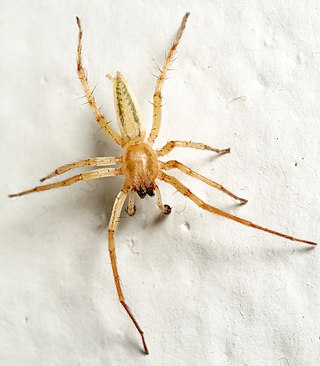
Anyphaenidae is a family of araneomorph spiders, sometimes called anyphaenid sac spiders. They are distinguished from the sac spiders of the family Clubionidae and other spiders by having the abdominal spiracle placed one third to one half of the way anterior to the spinnerets toward the epigastric furrow on the underside of the abdomen. In most spiders the spiracle is just anterior to the spinnerets. Like clubionids, anyphaenids have eight eyes arranged in two rows, conical anterior spinnerets and are wandering predators that build silken retreats, or sacs, usually on plant terminals, between leaves, under bark or under rocks. There are more than 600 species in over 50 genera worldwide.

Oonopidae, also known as goblin spiders, is a family of spiders consisting of over 1,600 described species in about 113 genera worldwide, with total species diversity estimated at 2000 to 2500 species. The type genus of the family is OonopsKeyserling, 1835.
Tenedos is a spider genus of the family Zodariidae. It has around 72 species from Central and South America.

Theridion is a genus of tangle-web spiders with a worldwide distribution. Notable species are the Hawaiian happy face spider (T. grallator), named for the iconic symbol on its abdomen, and T. nigroannulatum, one of few spider species that lives in social groups, attacking prey en masse to overwhelm them as a team.
Lygromma is a spider genus of Central and South America. There are species with eight, six and no eyes. The eyeless L. anops is endemic to Galapagos, while the not closely related blind L. gertschi is found only on Jamaica.
Masteria is a genus of curtain web spiders that was first described by L. Koch in 1873. They occur in the tropics of Central to South America, Asia and Micronesia, with one species found in Australia. M. petrunkevitchi males are 4 millimetres (0.16 in) long and females are 5 millimetres (0.20 in) long. M. lewisi, M. barona, and M. downeyi are slightly smaller and have only six eyes.
Camillina is a genus of ground spiders that was first described by Lucien Berland in 1919. They are very similar to sister genus Zelotes.

Glenognatha is a genus of long-jawed orb-weavers that was first described by Eugène Louis Simon in 1887. It was considerably revised in 2016.
Stethorrhagus is a genus of South American corinnid sac spiders first described by Eugène Simon in 1896.
Chrysometa is a genus of long-jawed orb-weavers that was first described by Eugène Louis Simon in 1894. It is a senior synonym of Capichameta.
Metagonia is a genus of cellar spiders that was first described by Eugène Louis Simon in 1893.

Thymoites is a genus of comb-footed spiders that was first described by Eugen von Keyserling in 1884.




